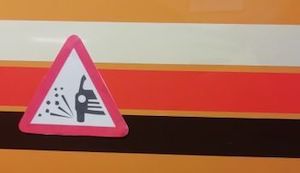Picture the scene: the year is 1976 and Renault have just launched a new car with a bit of a difference. It was lauded by the UK critics. Many muttering rotters of the day applauding its modern styling, practical ability and safe road holding. Like many great things, the rich pickings soon turned sour. In this case, a rotten fruit. But was it or better still, should it deserve the ridicule it obtained during its 7 year production run?
The car in question is the Renault 14. And it marked a departure for the French automaker. For the first time, they had a simple transverse engine layout running east to west. A gearbox under the engine. An overhead camshaft.
All sounds a bit lame by todays standards of multi everything, connected to this and that but back in 76, this was ultra modern for most makers especially Renault. For many years they had been using old engineering that was slowly being superseded by smoother engines with advanced improvements like overhead camshafts. These camshafts at the top made for smoother running engines. Add this to a gearbox that was mounted under the engine, also made the entire unit compact in size.
This engine was entirely new. From 1972, it was first seen as a little 954cc power pack in the new Peugeot 104. For Peugeot, this too was a whole new venture in engine design too. Still Gallic in its idiosyncrasies with a gearbox lubricated by the engines oil in the sump and just to add to the French style, the engine itself was tipped over 72 degress towards the bulkhead.
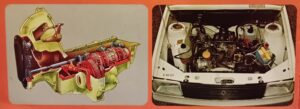
Makers strived to find optimum economy and the new engine was carbureted to suit this new world of more miles to the gallon. The gearing was set high. While this made it great on the motorway, it made it a slog when it came to hills. The original 1219cc was under powered for the day. Thankfully by dropping it down a gear, you could rev it to 8000rpm. It was an engine that thrived on revs. Keep them low and you would soon upset the 3 transfers gears. Already known for being noisy at idle, they would soon start making themselves heard like drag queens taking down a heckler.
As a result, Renault were able to design a larger family car that demanded only 50cm more of the same parking space as the acclaimed Renault 5 and only 10cm wider. This new car wasn’t to replace anything within the Renault range but to challenge the new breed of family hatchbacks that were emerging. The market was lucrative and the R5 didn’t fit the bill. The new car was also to be available only as a 5 door. All this new technology and 5 doors came at just over £300 more than the similar specified R5. That said, the R14 couldn’t quite compete for boot space with a maximum of 26 cu ft of luggage. Some 5 cu ft short to the R5.
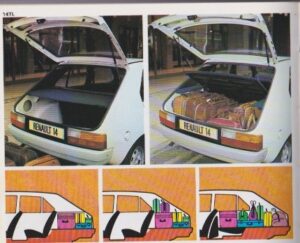
However, this new body was a bit too advanced for the world. Renault’s had always been perceived as being more as adventurous in design. Peculiar shapes, kinks here and there but here was a look that was smooth and jelly moulded in shape. Slap a Citroën badge on it and chances are it would have received a different welcome. The Ford Sierra outraged the world in 1982 with its jelly moulded look. Renault got there a whole 6 years before. This was the new era of slick design that all makers would eventually chase. It’s just that for some members of the public it was too advanced.
The R14 was a slippery and smooth. Blended in door handles, stylised door mirrors integrated into air flow of the doors were accentuated with higher spec models receiving graded graphics along the bonnets edge. Like the 5, the 14 had integrated bumpers designed into the shape. These were all modern touches that by today’s designs, seem to have vanished. The drag coefficient was respectable too.

What was missing visually were protruding wheel arches. European Car of the Year 1976, the Simca 1307 (Chrysler Alpine) had them. From 1979 to 1981 (Talbot Horizon, Lancia Delta, Ford Escort) all had them too. To see all 4 together, one car stood head and shoulders above them all and that was the R14. It would if we still lived in the design age of sleek elegance alas we do not. Now design language is about expressive anger, hate and a gapping mouth of an insulted Karen demanding to see the manager.
Putting Karen aside, the R14 was an elegant car to look at and compared to the Renault range of the day, was a standout fixture for what the future would look like. The smooth rounded shape like a pear was to become associated with mother nature. A PR stunt that would that was to come back to bite it on the arse. But those smooth looks soon lost favour when it came to high speed stability. The absence of a front spoiler meant the car could get blown off course in side winds. Something CAR magazine complained about a few times. And something that was never corrected over its 7 year production run even when it received a mid life facelift. The fabulously named Renault Boutique range of options and accessories however, did offer a spoiler.
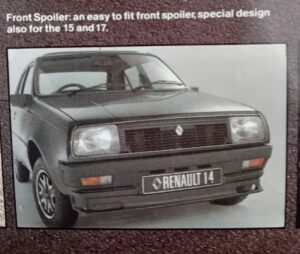
One thing that you couldn’t see in the brave new design were the piege a rouille which is a nicer was to say rust traps. Like most manufactures of the time, rust was rampant and Renault had their fair share of rusty failures. This red oxide rot that plagued the metal was soon added to mother natures less known forbidden fruit and soon the phrase “rotten pear” was coined and levied at the R14.
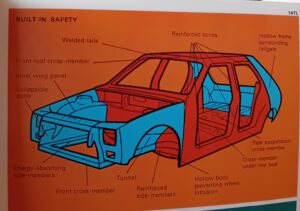
It seems quite harsh today to single out one model when the entire range from Renault became rotten within a few years and there were other makers of the tinbox who took rotting to a whole new level of evaporating steel. That said, there were others who had started to take this matter seriously and I don’t mean Volkswagen. Their Golf wasn’t impervious to damp weather unlike their Beetle.
All this negative press didn’t stop Renault from trying again. In 1980 a facelift of the front was designed. It integrated the indicators into front wings and there were some other improvements made. None however seemed to be about making the car better protected against the weather. After just 7 years and almost 1 million examples made, it was replaced by the bland R9. The ECOTY 1982 winner I might add and the much better in designed R11. The Renault with the magical fuel injection system that ran on fresh air after the fuel tank was smashed away in multiple collisions our British hero, 007 had with Parisian traffic in “A View To A Kill”.
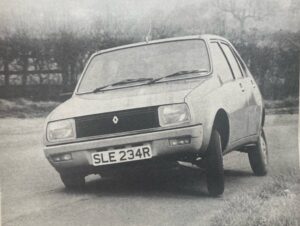
But should the Renault 14 be remembered as a failure or a success? According to “How many Left”, there are just 8 known surviving examples in the UK. And that is a shame. Road testers of the day reviewed the car favourably over its production life. And it wasn’t a bad car to look at either. I’ve never driven a 14 but have had many cars with the same engine and as engines go, it was quite a good unit. It wasn’t without its faults, camshaft wear was notably the most common fault along with head gasket failure. That wasn’t a great job to do but this was mostly due to neglect.
With this in mind, I envy the 8 UK residents who have one of these great little cars from Renault in their garage. A car ahead of its time in shape and one of the first forward thinking cost cutters using internal platform sharing and engines from another maker. Rotten to the core? Absolutely not. That accolade should go to the public who didn’t appreciate it at the time.
